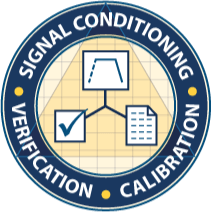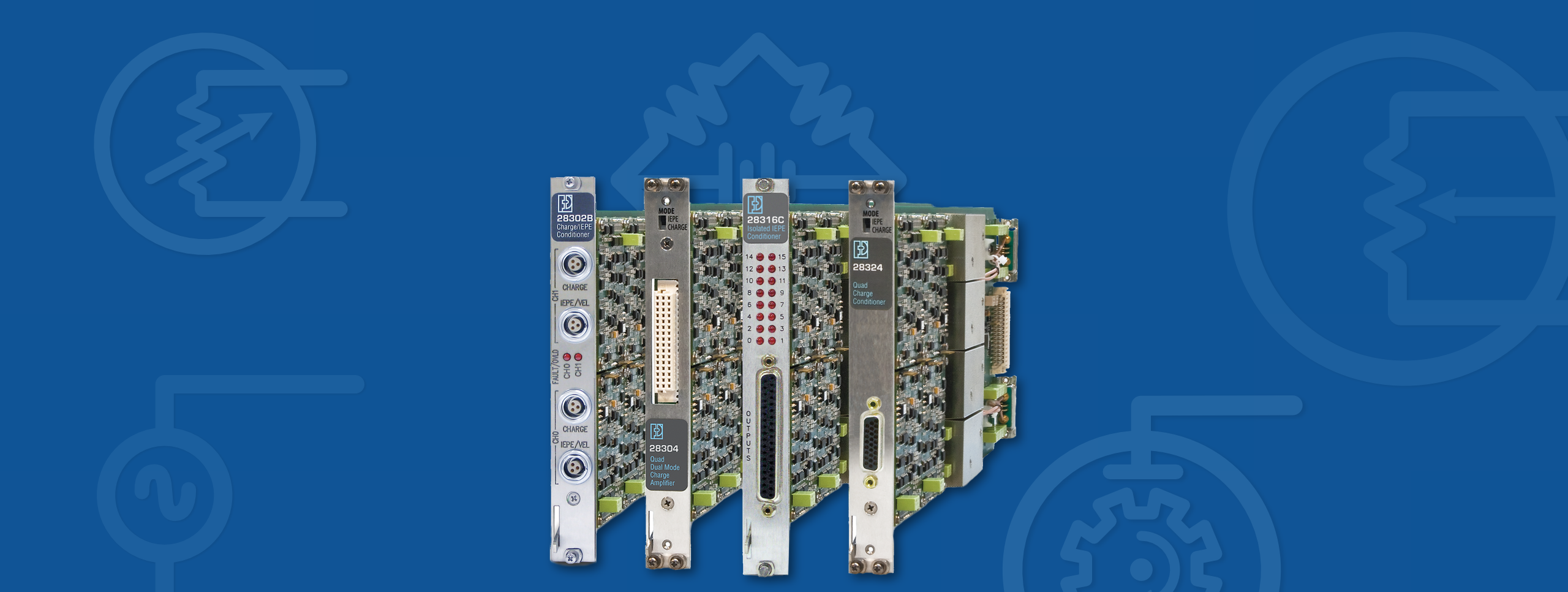Precision 28000 Solutions for Shock, Pressure and Vibration Measurements
Precision’s line of charge and IEPE filter amplifiers are ideal for conditioning piezoelectric sensors including those with integrated electronics. To break ground loops, we support grounded or floating sensors and differential charge configurations.
Our products are ideal for shock and vibration measurements including those where the sensor is exposed to harsh environmental conditions that include extreme temperatures and temperature gradients.
One common characteristic of accelerometers is an extremely low insulation resistance across the piezoelectric sensing element at high temperature. Precision’s charge amplifiers are compatible with the highest temperature accelerometers and are free from peaking effects that plague general-purpose charge amplifiers.
Measurements
- Shock Measurements
- Filtering for Shock Response Spectrum (SRS) Analysis
- High Temperature Piezoelectric Pressure or Vibration
- Low-Noise Differential Charge Measurements
- Piezoresistive Accelerometer for Shock
- IEPE Sensors for Vibration, Acoustics, Pressure Measurements
- Modal Analysis
- Vibration on Rotating Machinery
- Low-Level AC Voltage
Innovative Performance Technologies
Long Distance TEDS
PFI developed Long Distance TEDS (LDTEDS™) as a method of extending communication distances for TEDS sensors. While traditional TEDS sensors are limited to a distance of 300 feet between the signal conditioner and sensor...
Read MoreRead Less
PFI developed Long Distance TEDS (LDTEDS™) as a method of extending communication distances for TEDS sensors. While traditional TEDS sensors are limited to a distance of 300 feet between the signal conditioner and sensor, LDTEDS can communicate at distances to 1500 feet and beyond. LDTEDS has enabled TEDS sensors to be used for applications such as weapons test or vibration test on large structures where safety, environment, test article size and other factors often require cable runs in excess of 1000 feet.
Measuring Resonant Transducers
Some transducers such as piezo-resistive pressure transducers can have very high resonant frequencies that can be excited by transient events and this out-band signal can be larger than the signal of interest...
Read MoreRead Less
Some transducers such as piezo-resistive pressure transducers can have very high resonant frequencies that can be excited by transient events and this out-band signal can be larger than the signal of interest. Sources of unwanted low frequency noise can exist such as engine sub-harmonics, triboelectric noise from cable whip or pyro-electric noise from the sensor caused by the large temperature gradients.
The 28000 amplifier gain is distributed as “pre-filter” and “post-filter” gain to allow the filter to remove out-band signals such as transducer resonance while still achieving the required full-scale in-band signal level. Using the 28000 “reserve” feature, the user can specify the required protection against out-band noise and the pre- and post-filter gain are automatically distributed to provide this protection. The pre-filter gain is set to achieve the required amplifier headroom for the out-band signals prior to the filter while maximizing dynamic range. After the filter removes the out-band signals, the post-filter gain is set to achieve the desired full-scale output.
T-Insertion
The Precision Filters 28304 and 28324 accelerometer conditioners have built in “T-Insertion” capability to electronically stimulate the attached piezoelectric accelerometer to output a charge signal...
Read MoreRead Less
The Precision Filters 28304 and 28324 accelerometer conditioners have built in “T-Insertion” capability to electronically stimulate the attached piezoelectric accelerometer to output a charge signal. The charge output of a stimulated accelerometer is dependent on the exact properties of the accelerometer and connecting cable. And can be used to detect any change resulting from a faulty or damaged accelerometer. Additionally the stimulation frequency can be increased to interrogate the accelerometer in the vicinity of its mounted resonance frequency. Since resonance characteristics are affected by accelerometer mounting, high frequency performance can identify mechanical damage that occurred during a test run.
In summary, T-Insertion can be used as an “Electronic Tap-Test” to gather information on all accelerometer channels quickly and easily from the convenience of the control room. Pre- and post-T-Insert measurements can also be presented as a report that can greatly enhance QA documentation and add a new level of test validity documentation.
Extended Frequency Response of Resonant Sensors
The 28304 features patent pending REZCOMP™ transducer compensation technology that extends the useable frequency response of accelerometers, pressure sensors and microphones...
Read MoreRead Less
The 28304 features patent pending REZCOMP™ transducer compensation technology that extends the useable frequency response of accelerometers, pressure sensors and microphones in real-time with no need for data post-processing. REZCOMP is effective at compensating the seismic mass resonant response of an accelerometer, the organ pipe resonant response of a recessed mounted pressure sensor and the resonant response associated with the protective screen of a microphone sensor. With REZCOMP, useable sensor bandwidth may be extended to as much as 80% of the resonance, resulting in a 4X improvement in overall measurement bandwidth.
28000 Charge and IEPE Conditioners
- Dual Mode Charge and IEPE with LDTEDSTM
- Isolated High-Density IEPE with LDTEDSTM
- Charge/IEPE Amplifier for Rotating Machinery
Dual Mode Charge and IEPE Conditioners with Long Distance TEDS
The 28304 and 28324 provide four channels of signal conditioning for either Charge or IEPE type sensors. The 28304 features a versatile 4- or 8-pole filtering with programmable characteristics for both time or frequency domain applications and a filtered bandwidth up to 204.6 kHz or an unfiltered wideband width of 500 kHz. The economical 28324 features 4-pole filters with filtered bandwidth to 30 kHz and unfiltered bandwidth of 170 kHz.
Both cards feature the T-Insertion and Precision Filters’ LDTEDS™.
Dual Mode Charge and IEPE Conditioners Common Features:
|
|
28304 4-Channel Charge/IEPE Conditioner Features:
|
28324 4-Channel Charge/IEPE Conditioner Features:
|
Isolated High-Density IEPE with Long Distance TEDS
The 28316C Isolated IEPE Accelerometer Conditioner is a 16-channel card for IEPE (Integrated Electronic Piezoelectric) accelerometers or remote charge converters (RCC’s). In addition, the card functions as an AC filter/amplifier with balanced differential input for voltage input. Each channel input can be isolated to allow connection to grounded accelerometers without introducing ground loops.
The 28316C features “on-the-fly” sensor bias monitor and sensor open/short detection and Precision Filters’ LDTEDS™.
28316C Isolated IEPE Accelerometer Conditioner Features:
- 16 channels/card, 256 channels/system
- IEPE conditioner or AC Filter/Amplifier with balanced differential input
- Isolated channel input allows conditioning of grounded IEPE accelerometers without introducing ground loops
- Precision Filters’ LDTEDS™ (Long-Distance Transducer Electronic Datasheet) compliant
- Gain x1 to x512 with 0.1% resolution
- Programmable 4-pole low-pass filters
- Programmable IEPE current of 0, 2, 4, or 8 mA
- Sensor bias detector; in-range or out-of-range
- AC test current checks sensor, cable and signal conditioner health
- Overload detection
- Dual buffered outputs per channel.
- Test input (voltage substitution)
- Output monitor, selects any one of 512 outputs
The 28302B Dual Vibration Amplifier is a dual channel card designed to condition vibration signals from rotating machinery. The card accepts inputs from single-ended or differential piezoelectric accelerometers, IEPE accelerometers, or remote velocity sensors. Five AC outputs include two for acceleration, two for velocity and one for displacement, with one DC output for acceleration, velocity or displacement. The fully programmable 12-pole band-pass filter eliminates unwanted noise.
28302B Dual Vibration Amplifier Features:
- 2 channels/card, 32 channels/system
- Isolated or grounded single-ended piezoelectric input
- Balanced differential piezoelectric input
- IEPE input with IEPE power
- Remote charge converter (RCC) input w/IEPE power
- Remote velocity sensor input
- Five filtered AC outputs: two acceleration, two velocity and one displacement
- One DC output: acceleration, velocity or displacement
- Programmable alarm level with relay contact output measures acceleration, velocity or displacement levels.
- Internal shunt calibration capacitors with 0.1% accuracy
- Three overload detectors: Charge Converter, Pre-Filter, Displacement Out
- Channel Mute function places channel in low noise state if an accelerometer fails during a test run
Charge and IEPE Conditioner Selection Guide
For PDF version, click here
| Card | 28304 | 28324 | 28316C | 28302B-FX02 |
| Type | Single-Ended Charge, IEPE (GND or ISO) with Long Distance TEDS |
Single-Ended Charge, IEPE (GND or ISO) with Long Distance TEDS |
IEPE (GND or ISO) with Long Distance TEDS |
Single-Ended or Differential Charge, IEPE or Velocity Coil Input |
| Channels/Card | 4 | 4 | 16 | 2 |
| Channels/System | 64 | 64 | 256 | 32 |
| Applicable Transducer | Piezoelectric or IEPE Sensor, Remote Charge Converter, AC Voltage | Piezoelectric or IEPE Sensor, Remote Charge Converter, AC Voltage | IEPE Sensor with TEDS (Optional) and AC Voltage | Piezoelectric or IEPE Sensor, Velocity Coil, AC Voltage |
| Interface | 2-Wire Coaxial on Combo-D | 2-Wire Coaxial on Combo-D | 2-Wire with Shield |
Charge: 3-pin LEMO or Twinaxial BNC IEPE: 3 Pin LEMO or Coaxial BNC |
| Excitation | IEPE Current: 0, 4, 8, 12 mA | IEPE Current: 0, 4, 8, 12 mA | IEPE Current: 0, 2, 4 or 8 mA | IEPE Current: 8.5 mA |
| Bandwidth | 0.25 Hz to 450 kHz | 0.5 Hz to 170 kHz | 0.25 Hz to 140 kHz | 0.3 Hz to 20 kHz |
| Gain | x1/16 to x8192 with 0.05% Resolution |
x1/16 to x1024 with 0.05% Resolution | x1 to x512 with 0.1% Resolution |
PE: 1 to 200 pC/g IEPE: 0.1 to 200 mV/g (10 mV/g out) |
| Filter | 4-Pole Flat/Pulse Low-Pass with optional REZCOMP, 8-Pole Flat/Pulse Low-Pass or 8-Pole Band-Pass | 4-Pole Flat/Pulse Low-pass | 4-Pole Flat/Pulse, Time Delay or Butterworth | 6-Pole Butterworth High-pass, 6-Pole Elliptic Low-Pass |
| Cutoff Frequencies | Flat: 2 Hz to 204.6 kHz Pulse: 1 Hz to 102.3 kHz |
FX02: 300 Hz, 1 kHz, 3 kHz, 10 kHz, 30 kHzFX03: 10 kHz, 20 kHz, 40 kHz, 80 kHz, 100 kHz |
FX01: 100 Hz, 300 Hz, 1 kHz, 3 kHz, 10 kHz, BypassFX02: 300 Hz, 1 kHz, 3 kHz, 10 kHz, 30 kHz, Bypass |
HP: 0.3 Hz, 3 Hz, 10 Hz, 30 Hz, 100 Hz LP: 50 Hz to 12.75 kHz in 50 Hz steps |
| Outputs | (2) Buffered Single-Ended Outputs per Channel | (2) Buffered Single-Ended Outputs per Channel | (2) Buffered Single-ended Outputs per Channel | (2) Accel, (2) Velocity, (1) Displacement, (1) DC, (1) Alarm |

Verification at Test Time
Continual setup, tear down and reconfiguring of sensitive test equipment demands a rigorous protocol to prove that every channel is operating correctly at test time. The 28000 System provides a layer of built-in verification and validation capability to confirm proper operation of the measurement system including sensor and cable. Upon completion of the verification testing, a status report is provided as a defendable means to document system validity at the time of the actual test.
Yearly Calibration
All test systems require periodic calibration. The Precision 28000’s automated built-in test capabilities allow the user to perform convenient, affordable NIST traceable yearly calibration tests on-site without removing the system from the equipment rack. This eliminates the need for expensive off-site calibrations and system downtime.

